If you play an electric guitar, bass, or keyboard, there are multiple ways to diversify your tone. You can choose among various pedals providing more or less distortion to the primary signal. The best flanger pedal lets vary between multiple slight harmonics and the whooshing overdrive roaring while preserving the initial signal well traced.
Flangers are available in a variety of models, each of which is distinctive in its own manner. Look at the following parameters when choosing your first or next flanger device:
- Type. As lots of audio equipment nowadays, the flangers can be analog or digital. The latter are usually more versatile, with multiple recording and EQ options. The analog pedals might feature fewer options, but their output can be characterized as warmer and fuller, with richer harmonics and longer natural sustain.
- Controls. The amount of control knobs can vary from two to eight; besides, some controls can have dual functions (e.g. manual and resonance) being activated in a certain mode. The sensitivity of controls is also important; the more responsive they are, the more tailor-cut output you get.
- Connectivity. The modern flanger boxes can feature the inputs for electric guitar, bass, keyboard, vocals. They may feature mono and stereo inputs and outputs, allowing for even more distorted sound variants.
- Design. Flangers can feature a footswitch or a hand press button. Marks on the controls and visibility of inscriptions are important for quick operation.
Combine the key features and shape the best flanger out of the descriptions below!
Flanger Pedals Reviews
Boss BF-3
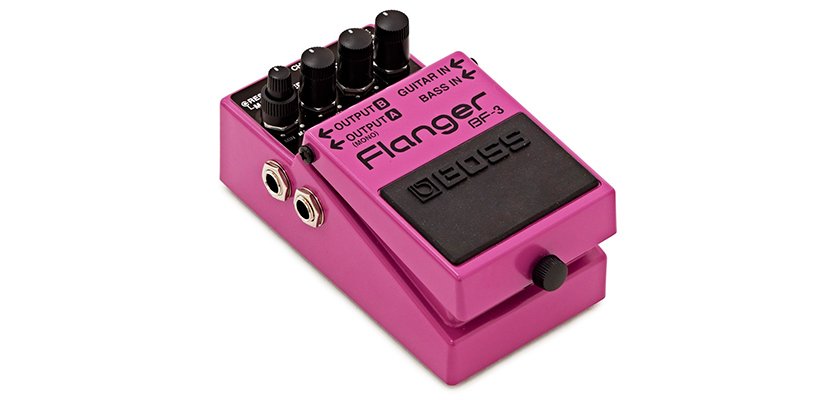
The Boss BF-3 may be the first pedal on your buying list if you need a flexible and dependable pedal that can be adjusted in a variety of ways. It has plenty of modes and inputs and is sturdy as all Boss pedals. Still, the variety of functions results in dual knobs, which might be not that convenient to monitor, especially in the dark area.
The pedal provides a solid rich sound full of harmonics and distorted and developed in many ways. The regular setting brings heavy low-end overdrive with distinct primary signal. The Ultra mode works well with the high-pitched passages providing consistent developing harmonics and long sustain. The Gate/Pan setting in this Boss flanger pedal recreates the tremolo-like coloration while the sound stays balanced and dense. The Momentary mode activates the flanger effect at once and keeps it on while the footswitch is pressed.
The control panel features four knobs, two of which are multifunctional. Together with standard Depth and Rate controls, there is a Mode knob setting one of the four modes, and the dual control for Resonance / Manual setting the range of the created effect. The big range provides a halo effect on all frequencies while the less range brings thicker sound with a lot of punch.
For bass guitarists, the Boss flanger features a separate input sparing the need for the adapters. This flanger machine is an excellent choice for both beginners and experienced guitarists looking for a variety of flanger effects in one instrument.
Pros
- Tap tempo function lets create multiple repeating harmonics and new effects.
- Supports both stereo and mono connections for clear sound output.
- Res/Manual is easy to control with the differently sized dials.
Cons
- No true bypass circuit.
- Raises the output volume.
Video Boss BF-3
TC Electronic Vortex
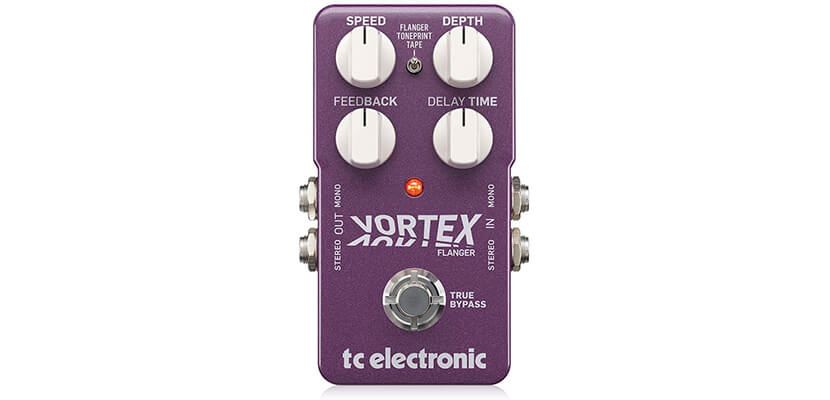
Featuring the enhanced digital design, the TC Electronics flanger provides a full range of flanger effects, from subtle tone coloration to the roaring of the reactive jet. It has a lot of functions, as well as a lot of connections and controls that are easy to use. Its flexible filtering system ensures a clear output with minimal to zero losses for various connection sets.
The effects created by the pedal are separated into three general modes activated with the toggle switch. The regular flanger mode allows the sound to whirl in harmonics and thick overdrive, according to the set positions of the knobs. Any effect, from iridescent tone coloration to the metallic tones, comes well-balanced and with the distinct initial signal, while the variations can reach the psychedelic passages characteristic for the early 70s.
The tape flanger mode mimics the 60s-70s flanger effects as used with the tape recording machines. That flanger effect is warmer while featuring less variety in settings. The specific TonePrint mode provides several effects characteristic for the sound of famous rock musicians like Jimi Hendrix, Metallica, Pink Floyd, and others.
The control panel has 4 big white knobs that are easily visible in the dark. They’re quite sensitive and easy to tweak. The toggle switch is sturdy and easy to operate. The pedal has several types of bypass circuitry including the true and buffered bypass and bringing the flexibility for gear connections. This model is worth being listed in the best flanger pedal chart, especially considering its mid price.
Pros
- TonePrint Editor app lets adjust the flanger effects and load them to the pedal.
- Both mono and stereo inputs and outputs.
- Analog Dry-Through technology provides a clear analog signal of guitar anytime.
Cons
- Rather lightweight (1.5 lbs), easy to kick away.
- No paper manual supplied.
Video TC Electronic Vortex
Other Nautila
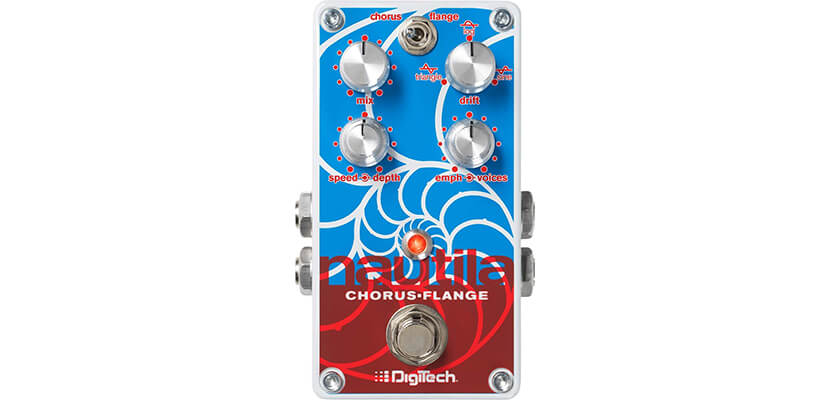
This flanger pedal has a unique design and a number of characteristics that make it a useful and versatile effect instrument. It combines two pedals in one letting blend the chorus and flanger effects and modulate the output in many ways.
The machine offers eight chorus and four flanger effects to combine and tune. With a variety of controls, it can create multiple effects. It can pitch your harmonics and make them edgy or create the foamy effect on each stroke of the strings. There’s also a lot of attack and concentration.
The controls make four knobs, two of which have double functions separated by dials of different sizes. There is a toggle selector and a footswitch for switching between chorus and flanger effects. The latter is highly responsive, with momentary feedback allowing you to perform the needed tempo delay and modify the effect to player’s liking.
The panel has Mix, Drift, Speed / Depth, Emphasize / Voices knobs providing versatile tweaking tools. The Drift knob sets the shape of the sound wave as logarithmic, triangular, or sinusoidal creating the various modes for frequency range and distortion.
Both the inputs and outputs of this flanger pedal are stereo-enabled, delivering a rich, expansive sound via the appropriate speakers. The true bypass gets the guitar signal through unharmed, without pitch cut or distorted. Flexibility and high quality of this stompbox let place it among the best flanger pedals for electric guitar.
Pros
- The modulation can be sped up in real-time via the footswitch.
- Silent and responsive controls and operation.
- Specific colorful design.
Cons
- Time delay at switching between flanger / chorus.
- Flanger effect lacks a super-heavy sound.
JOYO JF-07
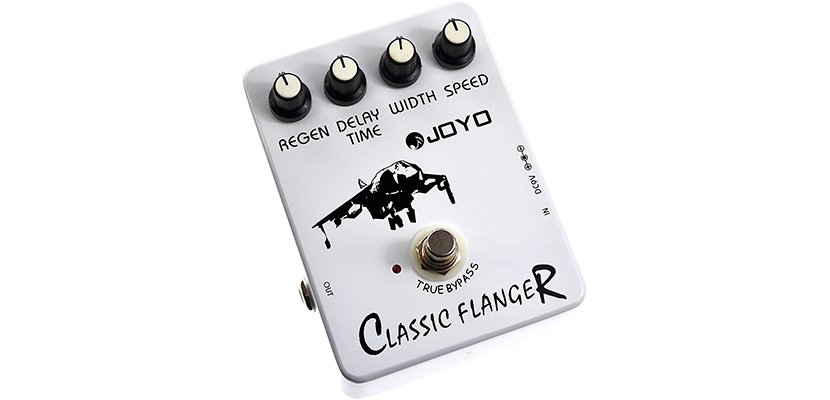
The metal effects created by this flanger pedal remind of the classic Metallica swirls and have a wide space for tuning. This stompbox has a simple appearance and a small number of connections, yet still offers straightforward and effective controls.
The pedal features Regen, Delay, Width, and Speed controls for shaping the sound wave and regulating the distortion, sustain, and development of new harmonics. The Regen dial controls the feedback (more or less feedback brought into the signal). The Delay Time one is responsible for the speed of the modulation swirl. The Width knob provides a tight true-to-source signal with minimal coloration at the minimal position and the thick harmonics at the maximum point. The Speed knob sets the overall speed of the effect and its concentration.
While costing as little as the entry-level flanger pedals, the JF-07 provides a wide range of effects, from metallic type flanger to chorus and vibrato. These effects can blend and bring up a well-balanced yet punchy sound.
When the footswitch is not engaged, the true bypass filter employed on this stompbox provides no perceptible sound coloring or reduction. There are one electric input and one output for the speaker or another gear in the chain. The pedal gets powered through the DC outlet (via the adapter) or from the 9V battery. The latter makes this stompbox a good option for gigs, sessions, travel, and so on.
Pros
- BBD simulation mechanism creates an effect close to the analog pedals.
- Sturdy die-cast casing.
- The amount of noise is very low.
Cons
- Knobs tend to go out somewhat of direct alignment after tweaking.
- Bypass switch is rather stiff (snap on / snap off type).
Video JOYO JF-07
Koogo
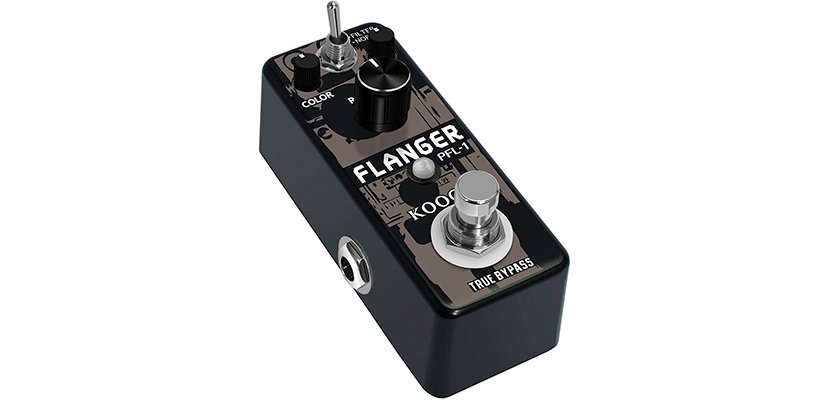
The distinct feature of this guitar flanger is its fully analog circuit bringing a warm sound of the rock pioneer compositions. It can turn the electric acoustic guitar sound into various harmonics having long sustain and continuous wave development.
The sound produced by this flanger is specific for its width and fullness of effect. It can be a slight warm coloration of the tone with fluent harmonics or thick metallic whooshing with the concentrated attack. There are three options for the initial effect, the Flat recreation of the signal and added coloration, the warmer Gentle mode, and the rocking Rumbling noise modulation. The effects feel rich in each frequency and have a characteristic vintage style.
The pedal incorporates the true bypass circuitry that separates the guitar signal from the pedal inner circuit once it’s not engaged. This produces a more genuine sound and distinguishes the pedal output.
The modulation panel on this flanger guitar pedal features the Rate, Range and Color dials, the Filter / Normal toggle selector, and the footswitch. The knobs are comprehensive with an immediate impact on the tone and effect. All the controls are sturdy and have good grip thanks to the ribbed surface. The box overall and connection ports (single input and output) are made of zinc alloy and prove to be solid and wear-resistant.
Pros
- Pure original “jet” flange sound.
- The Color knob is very sensitive and provides a wide range of frequencies, with the overall well-balanced output.
- Beautiful vintage design.
Cons
- Little bump sound at the footswitch press.
- No battery power supply.
Donner Jet Convolution
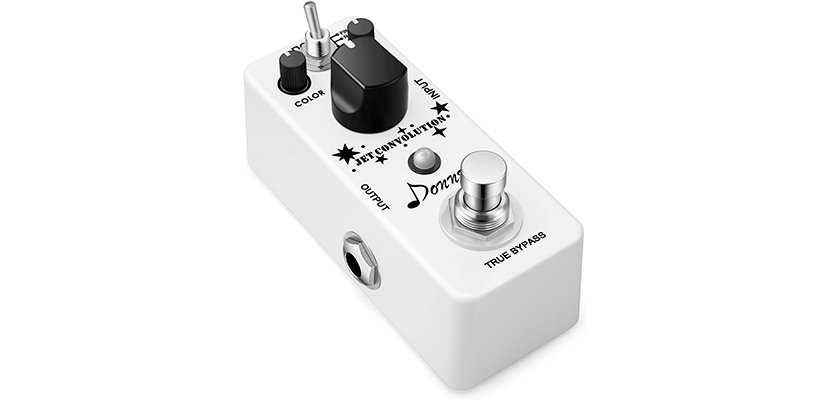
If you’re looking for the lifelike analog guitar flanger pedals able to roar and scream, providing a lot of effects in between, consider this model. It has snappy controls and is adaptable to most classic and hard rock compositions. It’s also quite small (6.6 x 4.7 x 2.6 inches) and won’t take much space on your pedalboard. Add a budget-friendly price to make this one of the most lucrative offers on the market.
The analog circuitry of the pedal brings warmth and richness to the sound. The latter reminds of the tape flangers creating a bright spacious headroom and long sustain. The pedal can be easily adjusted to any style and frequency range to boost the harmonics and emit gurgling swirls, metallic squeal, or subtle coloration of the main signal.
The regulators implemented in this Donner Jet Convolution stompbox are simple and comprehensive. The three knobs and the toggle switch plus the footswitch make all the controls. The Rate dial changes the speed at which the modulation unveils. The Color knob sets the depth of effect making it a bottom-creeping thick distortion or the light clear treble-oriented harmonics quickly spreading. The Range lets concentrate the sound for a potent punch or disseminate it into light waves.
Pros
- Solid analog ¼ input and output provides for little to zero signal noise.
- True bypass wiring cuts any tone coloration for the signal when the pedal is off.
- The aluminum alloy body is strong and lightweight (8.8 oz), making it ideal for travel.
Cons
- Drops the output volume.
- The plastic around the power port is brittle and tends to depart upon extensive use.
Video Donner Jet Convolution
Sonicake 5th Dimensionn
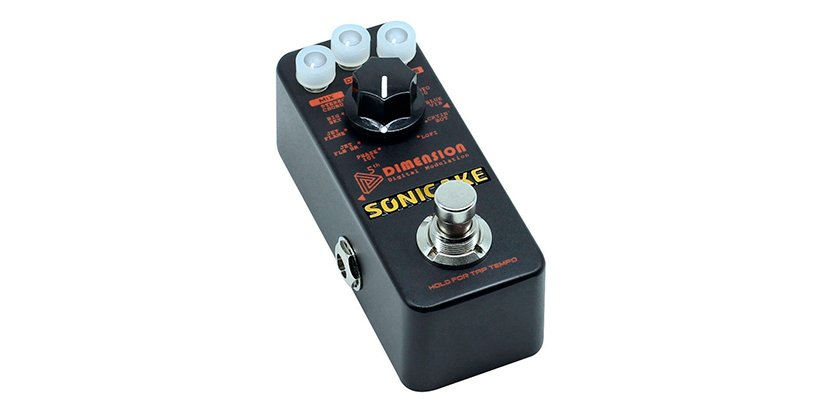
This flanger is one of the most versatile on the market offering the effects produced by flanger, phaser, chorus pedals. It features an original design and brings a variety of coloration modes for the guitar tone. It may also be attached to a bass guitar, being one of the competent bass flanger pedals.
The flanger is digital, with accurate circuitry and good overall build. It does sound an inch less warm than its analog competitors; yet, the dense attack it creates on a level with multiple signal modulations provides a full-range sound. The effects vary from the clean tremolo passages to the roaring jet sound, with quite a lot in between. The sustain has good length and the harmonics develop smoothly and clearly.
Controls on this pedal represent the three knobs (Mix, Depth, and Rate) and the large modulation knob in the middle of the pedal. The sound adjusting knobs are strong but sensitive, and they control the range, volume, and speed of the selected sound effect.
The modulation knob features eleven options that, combined with the tuning knobs, create a diversity of effects. These make the phaser-like distortion, a variety of jet-like roaring coloration tones, a stereo chorus effect, different tremolo styles, vibrato effect.
This chorus flanger pedal also uses True Bypass technology, which allows the signal to flow through unaltered and only activate the sonic alterations when the footswitch is pushed.
Pros
- Magnatone style vibrato, auto wah, and bit crusher effects sound natural and balanced.
- Tap tempo function provides enhanced delay control over the speed of effect.
- Well-visible wide fluorescent knobs.
Cons
- Each effect requires the separate tone tuning (no immediate switching between effects).
- Gets warm upon an hour-long use.
Video Sonicake 5th Dimension
Jim Dunlop MXR M152X
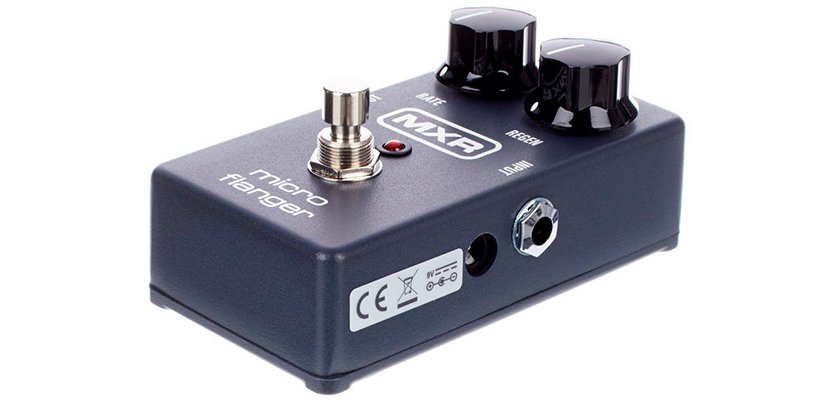
The entirely analog built of this MXR flanger makes a solid background for its rich natural tone featuring warmth and depth while not feeling retro-style. It’s capable of replacing the larger analog pedals by MXR preserving the tonal variety and powerful attack within the smaller footprint. The controls are limited to two regulating the effect of spreading and other parameters.
The BBD mechanism is used by the pedal to give the distinctive analog delay to the signal. The Rate and Regeneration knobs are responsive and let control the effect delay and speed resulting in the tailor-cut sound signature. The pedal is capable of producing a wide range of effects from slight chorus reverb to the potent overdrive and multiple clear low-end harmonics. The sustain preserves the signal for long without losing its strength and sonic coloration.
The pedal has a branded MXR design, with the same tint of color for the finish, a logo in the middle, and distinctive black knobs with small niches for fingers. The pedal supports one input that could be used for the electric guitar or bass guitar and the output for an amp, powered speaker, another pedal or another acoustic gear. This bass flanger has a small footprint (8 x 3 x 3 inches), fits any pedalboard, and is handy for carrying along to a session or rehearsal.
Pros
- Large bright headroom.
- Safe dialing, no abrupt effect change, or circuit-breaking winding of the knobs.
- Real true bypass — no signal degradation.
Cons
- No subtle flanger setting.
- Costs twice as much as basic models.
Video Jim Dunlop MXR M152
Buyer’s Guide
What does a Flanger Pedal Do?
The flanger effect is created by applying the same signal modulated by its speed and time, to the initial signal. This happens on basis of low-frequency oscillation and depending on the range and level of the effect that can produce the mild iridescent harmonic halo around the primary tone or a powerful whooshing sound of a jet plane taking off.
The first flangers were based on the tape machine recording with desynchronization of the sound during the spool “copying”. The effect was noticed and then developed into the analog and digital pedals called “flangers”.
The analog flangers preserve the tone of the initial signal providing the precise copy of it delayed by the determined time period. This sound is said to be more realistic and powerful than that generated by digital boxes.
The latter usually provides more control over the tone making it vary from hard rock attack to slight coloration. This diversity makes flangers serve as the chorus, vibrato, and other effects as well. Still, the most characteristic flanger sound is the multiple tone variation full of harmonics and called the “psychedelic” style and the roaring “jet sound”.
Functions of a Flanger Pedal
Rate
This control defines the level of the effect produced by the flanger and is tuned independently for each tonal setting. It can range from subtle to abrupt attack and even produce some damage to equipment and / or hearing in case of budget pedals.
The rate defines the frequency limit of the sound waves. Visualized as a diagram, it would mark the speed with which the wave rises or falls to peaks (both high and low ones) of the signal.
The rate is connected with the speed of sound wave modulation. The higher the peaks, the more abrupt are the sweeps. The fine tuning of the rate can produce a balanced dense sound imitating the original analog flanger effect.
Depth
Depth is responsible for the actual coloration of the tone and affects the different “stages” of the flanger sound. It sets out the intensity of the flanger effect in the chose tone. The more depth you set, the more intense is the flanger, the more metal there is in the sound.
The Depth control allows separating the tonal modes in the flanger. Approximately one-third of the knob turning capacity will make the sound more distinct but still natural, with analog warmth. The more you wind up the knob, the more synthetic the sound becomes, with the metallic squealing at the peaks.
Resonance
This control is another side of flanger effect intensity and coloration. Using the above diagram example, the resonance marks the peaks determining how high the sound wave rises or falls. As such, it defines the range of highs and lows produced by the flanger.
This parameter isn’t a set one and can vary in different pedals. Some boxes produce a flanger effect within the limited resonance while others can have a vast range. Usually, the less the resonance range, the more concentrated and true-to-source the sound is. Higher resonance, though, can produce the wild whooshing passages characteristic for certain hard rock styles.
Manual
This control is present on several flanger models, but many pedals incorporate this setting into the Resonance knob. On a sound diagram, it fixes the center of the sweep the signal wave makes and influences both the level of sound distortion and the flanger effect.
Winding the Manual high you will receive the aggressive sweep and the considerable tone distortion. Setting it low, you’ll have the subtler transition, with less punch and distinction of the flanger effect. Balancing the manual, it’s possible to reach the optimal setting for the flanger being represented in full and the primary sound staying recognizable.
How to Use a Flanger Pedal?
Setting the flanger takes more than a few seconds, as shown by a lot of controls. It can’t even work out of the box. Each electric guitar, the music style, the amp used will define the independent flanger setting, and so will the player’s individual taste.
Used in a chain of the pedals, the flanger is better to be put at the end of the chain, with the direct connection to the amplifier or a powered speaker. However, if the delay box is used, it’s preferable to put the flanger before it. The flanger has rather an aggressive effect on other pedals in the chain and thus, is seldom used at the beginning of the chain.
Start tuning the flanger from the lower positions of all knobs. Mainly, the Resonance and Manual (if any) should be set to low indication, and so should the rate. Upon that, tweak the Rate and Depth to find a sweet spot for your desired flanger effect. If you went past the full round and haven’t spotted the desired sound, try to increase the Manual and then the Resonance and continue tuning the Depth and Rate. If you have a tap tempo function, use it with the Rate control to determine the effect it has on the sound.

Hi everyone! I’m Thomas Moody, also known as Guitarzan.
